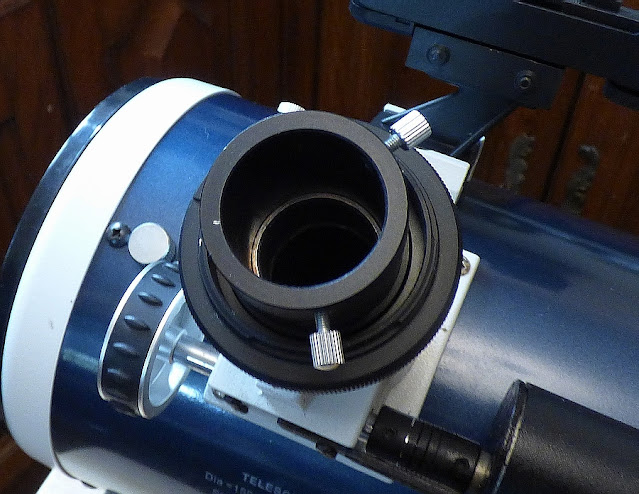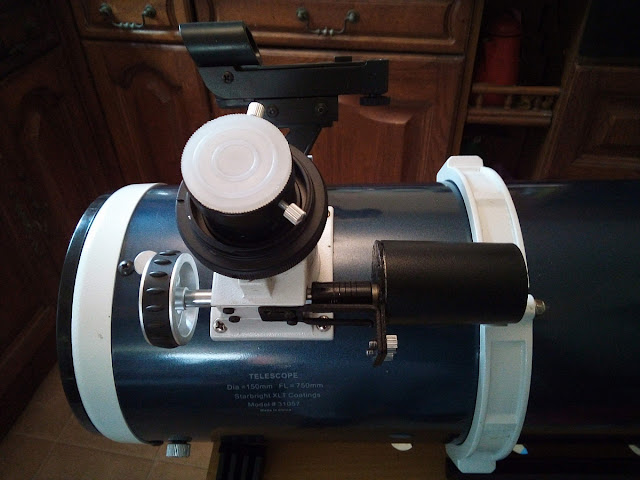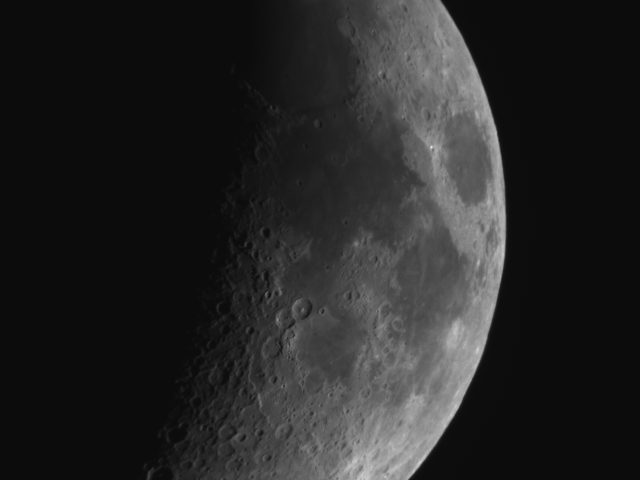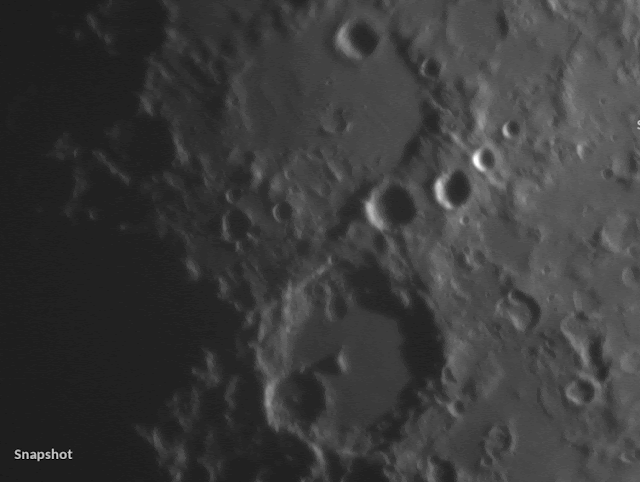Screenshot of AstroDMx Capture for Linux capturing data on the Trifid nebula
The Trifid nebula showing diffraction spikes on the brighter stars
The Swan nebula showing diffraction spikes on the brighter stars
Many people find these diffraction spikes attractive. Some software has functions to add artificial diffraction spikes to images from refractors, and some even place cross wires across the front of a refractor to create real diffraction spikes.
The diffraction spikes are caused by the spider supports for the secondary mirror in a newtonian reflector.
Newtonian reflector showing the spider supporting the flat secondary mirror
The diffraction spikes are caused by the fact that light really does bend around the spider vanes, so that interference patterns are created. This bending of light around edges leads to the fact that shadows always have soft edges rather than hard, sharp edges.
The first recorded accurate observations of the diffraction of light and the naming the phenomenon 'diffraction' were due to the Italian Francesco Maria Grimaldi in 1660.
James Gregory FRS discovered diffraction gratings by passing sunlight through a feather and observing that the light was split into the colours of the rainbow and a diffraction pattern was observed. In a letter to the mathematician John Collins in 1673, he invites Collins to inform Isaac Newton of a small experiment that he performed by allowing sunlight through a small hole into a darkened house, and passing the light through a feather onto white paper. He observed a number of small circles and ovals around a central white point and the rest being 'severally coloured'. Of Newton, he says 'I would gladly hear his thoughts on it.'
He made this observation a year after Isaac Newton had published his work in 1672 on using a prism to split white light into its component colours.
We did a more modern version of Gregory's experiment, by shining lasers of different coloured light through a feather and observing the diffraction patterns produced. In this animation, it can be seen that the red dots produced by a red laser producing coherent light of 650nm wavelength, were further apart than the green dots produced by a green laser producing coherent light of 532nm wavelength.
Animation of the passing of red and green laser light through a feather.
The feather was examined under a microscope where the cross-axis structure of the barbs and barbules between them could be observed.
AstroDMx Capture connected to a USB electronic microscope
High power image of the barbs and cross, barbules between them
To make the observation even clearer, the red and green laser light was passed alternately through
diffraction gratings; one grating was a one-axis grating and the other was a two axis grating.
Animation of the passing of red and green laser light through a one axis diffraction grating.
Animation of passing red and green light through a two axis diffraction grating.
In each of these animations it can be seen that the dots of the red diffraction interference pattern are further apart than the dots of the green diffraction interference pattern. This is because longer wavelengths are diffracted through greater angles than shorter wavelengths.
To demonstrate this further a, blue laser producing coherent light of 405nm was introduced and the diffraction patterns produced by all three lasers, with otherwise identical optical geometries, at the same scale, were combined into a single image.
Combination of images of diffraction patterns produced by red, green and blue light
Shining light from a white LED through the two diffraction gratings produced spectra showing that long wavelengths are diffracted more than short wavelengths.
Single axis diffraction grating
In this example, the source of white light is to the right of the grating and low down
Two axis diffraction grating
In this example, the source of light is behind the grating.
In contrast to a diffraction grating, a prism refracts short wavelengths more than long wavelengths. This experiment was done with a prism in a darkened room with sunlight allowed through a slit onto a prism that was standing on a sheet of white paper. The light was coming from the right.
It can be seen that the shorter wavelength blue light was refracted through a greater angle than the angles through which the longer wavelengths green, yellow and red light were refracted. This phenomenon is responsible for the atmospheric dispersion seen when imaging planets low in the sky. The atmosphere acts as a prism and refracts the short wavelengths higher away from the sun.
This is an image of Venus captured with a ZWO ASI178MC camera using a region of interest and a Skymax 127 Maksutov mounted on a Celestron AVX mount. A 10,000 frame SER file was captured by AstroDMx Capture and the best 10% of the frames were registered and stacked in Autostakkert!
The Sun was below the horizon on the bottom right.
Animation of the Stacked images with and without RGB channels registration.
It can be seen that the blue light was refracted further away from the direction of the Sun than was the red light, creating the atmospheric dispersion effect.
In 1663 Gregory wrote a book entitled Optica Promota (The Advance of Optics) which was about lenses and mirrors, but contained a description of the first reflecting telescope that used a parabolic mirror. This was five years before Isaac Newton produced his first functional reflecting telescope in 1668. It is possible that Newton had read Optica Promota, so he could have been influenced by Gregory. James Gregory didn't have the skills to build the telescope for himself and had difficulty trying to find an optician with the necessary skills to build one for him. It was eventually built by Robert Hook ten years later.
The Gregorian telescope had a Cassegrain configuration with folded optics so that the image was brought out through a hole in the centre of the primary mirror to what has become known as the Cassegrain focus after the design of a reflecting telescope published in 1672 in Journal des sçavans, the first academic journal to be published in Europe. Other people were also working on reflecting telescopes at this time. In fact, the idea was not new as Galileo Galilei and others had previously discussed the use of a mirror as the objective.
The Swansea Astronomical Society owns a Gregorian telescope shown here
Gregorian reflector
Gregorian reflector
In 1668, the same year that Newton produced his reflecting telescope, Gregory was elected to the Royal Society. Newton was elected to a Fellowship of the Royal Society four years later in 1672.
Using diffraction spikes to achieve perfect focus using a Bahtinov Mask
The Bahtinov mask was invented in 2005 by the Russian astrophotographer Pavel Bahtinov as an aid to the precise focusing of telescopes by making use of diffraction spikes. The Mask is placed at the front of the telescope, It has three sets of slots at angles as shown in the image. When pointed at a bright star, 3 diffraction spikes are produced that move in relation to each other as the scope moves through focus. When the star is in perfect focus, the central diffraction spike is exactly central in relation to the other two spikes. When it is out of focus, the central spike is on one side of centre or the other side, depending on whether the star is inside or outside focus.
Bahtinov Masks
Bahtinov Mask on the front of a telescope
A ZWO ASI178MC camera was placed at the Newtonian focus of a 6", f/5 Newtonian, with a Bahtinov mask fitted to the front. The scope was aligned on Altair.
AstroDMx Capture for Linux was used to capture snapshots of the diffraction spikes, either side of focus and at perfect focus. An animation was produced.
Diffraction spikes produced by a Bahtinov mask at perfect focus and either side of focus
Focus is adjusted until the central spike is exactly central between the other two spikes as shown above. When the scope is either side of focus, the central spike is not central with respect to the other two spikes.
AstroDMx Capture for Windows, macOS or Linux (Including Raspberry Pi) can be downloaded freely here:













































